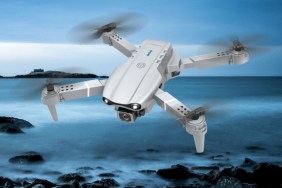I am not technophobic. While the likes of Elon Musk, Steve Wozniak and Bill Gates may be worried that artificial intelligence will advance to the point where humanity is forced to perform some sort of Matrix-esque uprising against the machines we created, I for one welcome our future robot overlords. I mean, let’s be honest: we haven’t been doing a great job of running things around here. Global warming is slowly killing our planet, we’re still struggling to prevent our fellow human beings in faraway lands dying from starvation and someone invented the selfie stick. It’s pretty bleak.
Also See: Apple Has Gone Hysterically Over-The-Top With Its Apple Watch Customer Service
But despite me not really having any qualms with human civilization eventually being run and monitored by computers, I am quite unnerved by the prospect of drones delivering our shopping to our front door. When the Amazon Prime Air was first unveiled I, like many others, naturally assumed it was a joke. But no – Amazon is really pushing ahead with its delivery drone concept, so much so that the company is now test-running them just 2,000 feet from the US border in British Columbia, Canada, after the Federal Aviation Administration (FAA) reportedly took too long to give the go-ahead for the drones to fly within US airspace.
The FAA Problem
The Amazon Prime service already offers next-day delivery on millions of items, so it’s questionable just who would be impatient enough to want to pay for a drone to deliver their package instead. Sure, there are some perks when it comes to replacing delivery vans with drones – for one, you would no longer have to bother with human contact, with you even able to rid your day-to-day existence of the forced conversation between yourself and delivery drivers if you’ve decided to live your life as a hermit – but none of them really serve to quell the fear that the US may soon find its blue skies filled with a sea of drones, hovering above our heads whilst Amazon blasts ‘Flight Of The Valkyries’ from out of their speakers.
This is what shopping deliveries will look like in a few years’ time.
In Jurassic Park, Ian Malcolm criticizes John Hammond’s cloning experiments by saying: “Your scientists were so preoccupied with whether or not they could that they didn’t stop to think if they should.” And d’you know what happened in Jurassic Park? People were eaten by dinosaurs. Like, lots of people. Drones are currently being used for a myriad of different purposes, from personal use through to providing medical aid in emergency situations, so while they certainly have their uses it’s highly questionable whether one of those uses should be flying to your house, dropping a blu-ray off at your front door before being attacked by your neighbor’s dog.
Though Amazon is currently testing the Prime Air drones to tighten up their object detection capabilities and ensure that they can safely fly through their surrounding environment without causing needless harm to the civilians unwittingly walking below them, it’s still somewhat unlikely that the company will ever be able to get the tech approved by the FAA due to them currently enforcing a “line of sight” ruling which states that any commercial drone must remain within eyesight of the individual controlling it at all times. This means that unless Amazon were to send out a drone operator to stand 20-feet away from your home in order to make the delivery, in which case the entire process would be even more pointless than it already is, they aren’t going to be able to continue with their little venture at any point in the near future.
But the retailing giant must be somewhat confident of its ability to eventually get the service up-and-running if it’s decided to send a team over to Canada in order to test it out, unless they just wanted to stick their middle-finger up at the FAA like a petulant teenager by flying the machines around in Canada for a little while, though that seems unlikely. It seems that Amazon is really pushing for this concept to become a reality, then, but it’s not one that I can, or want to, envisage. Amazon has been vocal about its problems with communicating with the FAA, but in all likelihood the aviation organization won’t want to be held partially accountable if the service presents any problems, of which there could potentially be many. I can’t say I blame them.
Paul Tamburro is the Tech & Gadgets Editor of CraveOnline. Follow him on Twitter @PaulTamburro.









